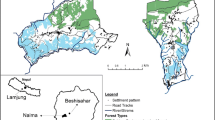Abstract
Nepal’s historically successful practice of community forestry has demonstrated the importance of encouraging relevant stakeholder groups to participate in the decision-making process and foster successful management and use of forest resources. Concerns over potential inequity in policy construction can be mitigated by fully involving experts as well as local community forest users whose daily subsistence is heavily dependent on forest products. This study analyzes the preferences of conservation experts and community forest users in consideration of three forest types in the Mid Hills region of Nepal: Pinus roxburghii, Alnus nepalensis and Schima-Castanopsis. All three have distinct benefits for conservation as well as for the provision of forest products and potential to improve the local economy and livelihoods. Focus group discussions were conducted with both groups of stakeholders to identify and later compare local and conservation benefits for the three forest types with the help of the analytic hierarchy process through repeated pairwise comparisons. Overall, this study finds that Schima-Castanopsis is the preferred forest type for satisfying both the subsistence needs of local forest users and the conservation concerns of forestry experts. This study also addresses the importance of combining the views of both groups in order to create a representative and effective forest management policy.

Similar content being viewed by others
References
Agrawal A, Gupta K (2005) Decentralization and participation: the governance of common pool resources in Nepal’s Terai. World Dev 33(7):1101–1114
Boyer-Rechlin B (2010) Women in forestry: a study of Kenya’s green belt movement and Nepal’s community forestry program. Scand J Res 25(9):69–72
Catron J, Stainback GA, Dwivedi P, Lhotka JM (2013) Bioenergy development in Kentucky: a SWOT-ANP analysis. For Policy Econ 28:18–43
DFO (2006) Monitoring and evaluation report of community forests. Government of Nepal, Ministry of Forest and Soil Conservation, Department of Forest, District Forest Office, Parbat
DFO (2010) Monitoring and evaluation report of community forests. Government of Nepal, Ministry of Forest and Soil Conservation, Department of Forest, District Forest Office, Kaski
Dogra PD (1985) Conifers of India and their wild gene resources in relation to tree breeding. Indian For 111(11):935–955
Dwivedi P, Alavalapati JRR (2009) Stakeholders’ perceptions on forest biomass-based bioenergy development in the southern US. Energy Policy 37(5):1999–2007
ExpertChoice (2010) Expert Choice Inc. Arlington, VA
Gauli A, Gailing O, Stefenon V, Finkeldey R (2009) Genetic similarity of natural populations and plantations of Pinus roxburghii Sarg. In Nepal. Ann For Sci 66(7):703
GC DB (2008) Carbon sequestration potential and uses of Dendrocalamus strictus (a case study from Sigana VDC, Baglung). A thesis submitted in partial fulfilment of the requirements for the Degree of Bachelor of Science in Forestry. Tribhuvan University, Institute of Forestry, Pokhara
Jackson JK (1994) Manual of afforestation in Nepal, 2nd edn. Forest Research and Survey Centre, Ministry of Forests and Soil Conservation, Kathmandu
KC B, Stainback GA (2012) Financial analysis of Chir pine plantations for carbon offsets, timber and resin in Nepal. Banko Janakari J For Inform Nepal 22(2):3–10. doi:10.3126/banko.v22i2.9193
KC B, Stainback GA, Chhetri BBK (2014) Community users’ and experts’ perspective on community forestry in Nepal: a SWOT-AHP analysis. J For Trees Livelihoods 23(4):1–15
Kurttila M, Pesonen M, Kangas J, Kajanus M (2000) Utilizing the analytic hierarchy process (AHP) in SWOT analysis—a hybrid method and its application to a forest-certification case. For Policy Econ 1(1):41–52
Mendes P (2011) Demand driven supply chain-a structured and practical roadmap to increase profitability. Springer, Berlin
Pandey R, Harrison S, Gupta AK (2014) Resource availability versus resource extraction in forests: analysis of forest fodder system in forest density classes in lower himalayas. India Small Scale For 13(3):267–279
Paudel D, Khatri DB, Paudel G (2010) Corpo-bureaucratizing community forestry: commercialization and the increased financial transaction in community forestry user groups in Nepal. J For Livelihood 9(1):1–15
Pokharel BK, BranneyP Nurse M, Malla YB (2007) Community forestry: conserving forests, sustaining livelihoods and strengthening democracy. J For Livelihood 6(2):8–19
Saaty TL (1977) A scaling method for priorities in hierarchical structures. J Math Psychol 15(3):234–281
Saaty TL (1980) The Analytic Hierarchy Process. McGraw Hill, New York
Saaty TL (1993) The analytic hierarchy process: a 1993 overview. Cent Eur J Oper Res Econ 2(2):119–137
Saaty T (2004) Decision making—the analytic hierarchy and network processes (AHP/ANP). J Sys Sci Sys Eng 13(1):1–35
Saaty TL, Vargas LG (2001) Models, methods concepts and applications of the analytic hierarchy process. Kluwer Academic Publishers, New York
Stainback GA, Masozera M, Mukuralinda A, Dwivedi P (2012) Smallholder agroforestry in Rwanda: a SWOT-AHP analysis. Small Scale For 11(3):285–300
Thakur RB (2003) A compendium of tree species of Nepal. Sarvottam Offset Printing Press (P.) Ltd, Kathmandu
Thoms CA (2008) Community control of resources and the challenge of improving local livelihoods: a critical examination of community forestry in Nepal. Geoforum 39:1452–1465
Vaidya OS, Kumar S (2006) Analytic hierarchy process: an overview of applications. Eur J Oper Res 169(1):1–29
Xia W, Wu Z (2007) Supplier selection with multiple criteria in volume discount environments. Omega 35(5):494–504
Xu Z (2000) On consistency of the weighted geometric mean complex judgement matrix in AHP. Eur J Oper Res 126(3):683–687
Yi WZ, Raven PH (1999) Flora of China, vol 4. Science press, Beijing
Acknowledgments
We would like to acknowledge the University of Kentucky for funding to carry out this study, and to express our appreciation for the contribution made by all the participants from focus group discussions. We would also like to thank many colleagues who helped us during the data collection.
Author information
Authors and Affiliations
Corresponding author
Rights and permissions
About this article
Cite this article
KC, B., Stainback, G.A. & Rayens, K. Comparison of Three Major Forest Types of Mid Hills Region of Nepal for Conservation and Local Benefits. Small-scale Forestry 14, 479–491 (2015). https://doi.org/10.1007/s11842-015-9299-5
Accepted:
Published:
Issue Date:
DOI: https://doi.org/10.1007/s11842-015-9299-5




